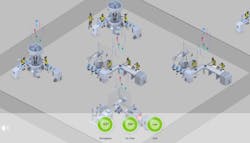"I felt obsolete," the rust-haired computer programmer said after IBM's supercomputer Watson usurped his position. "I felt like a Detroit auto worker of the '80s seeing a robot that could do his job on the assembly line."
Jennings, who won 74 matches of the trivial knowledge game show in a row, explained in a TedTalk that he thought there was no way the AI could pick up on the various clues' nuances and double meanings.
Watson, it turns out, was not only a fast thinker (16 TB of RAM) with a great memory (1 TB), it also understood context. It cleaned the stage floor with Jennings, beating him by $53,147.
With that victory under its belt, Watson has moved on from the game show circuit to uses its powers and contextual brilliance to take on something even bigger: manufacturing.
Inviting Watson to connect with all your Industry 4.0 machines and sensors has been proven to reduce equipment downtime and extend their life, improve process and product quality, and optimize product development. According to IBM, one manufacturer was even able to double its output without doubling assets.
Game Theory
To show how this is possible, IBM gamified Watson, in the styling of one of those classic "Choose Your Own Adventure" books. It's called Industry 4.0 Model Factory and you can play it here. It works on PCs and smart devices.
As the resident gamer here in the office, I gladly volunteered to test it out and see what it's all about.
The simulation puts me in charge of a shoe plant where I'm tasked with producing 2,000 blue and 3,000 tan units.
Everything is humming along smoothly, until out of nowhere, the evil villain of unpredictable weather comes knocking. It uses blizzard attack on my tan materials supplier, and it's super effective. Watson Weather Alert estimates a 35% risk of disruption.
In gaming terms, this is basically like Donkey Kong dropping a barrel on your head.
My factory's throughput drops from 99% to 81% and my on-time deliverables fall from near perfect to 72%.
The prompt asks to choose between acting at 50% or 75%. In most of my life, I'm a procrastinator, but there seems to be a lot of simulated workers and their families in the Matrix counting on me, so I act immediately.
Play Industry 4.0 Model Factory
Hooray, tan units are ahead of schedule! My orders are 91% on-time and my risk is low. Crisis averted.
Immediately, this makes me wonder what would have happened if Watson was on the job in 2010 when Iceland's Eyjafjallajökull volcano erupted. The plume of ash inflated to cover much of the North Atlantic, disrupting flights across the globe. The International Air Transport Association estimated the airline industry lost $1.7 billion, so you can guess what impact that had on the world's supply chain. Kenya alone had to destroy 400 metric tons of flowers earmarked for Europe.
Which means, at just one disaster in, I'm already seeing the point of this system. In a real world, harnessing this smart game's brain could have dramatic impact across the whole supply chain.
For the next quest in this simulation, Watson has noticed irregular vibration and temperature readings in my tan shoe assembly machine. Now I have to decide whether to fix this one machine and avoid any tan delays, or retool all lines for blue.
I figure, if one machine has a problem, there might be more problems afoot. So I switch the whole line to blue, and the simulation says I prevented a disruption and boosted blue output. The game doesn't give me any points or extra lives, but we can only hope my virtual shareholders take notice and give me a hefty pretend raise.
Finally, when it's time to make repairs, Watson is my Sherlock, ready to deduce what's going on simply by talking to it. In the simulation, the HMI is a tablet. After using that amazing processing power first developed to crush Ken Jennings, it informs me that "Part A12 may fail after 370 hours of operation if humidity tops 50%."
Way to almost ruin it for everybody, A12.
Well, now Watson knows the real culprit and applies that knowledge to the rest of the factory. For at least the next month, no outages are predicted and everything is back to being on time and on budget.
It's not as satisfying as rescuing a princess or saving the planet from alien invasion, but this game does have a satisfying ending.
Potential Impact
As a bonus game, IBM offers a quick four-question survey to assess where you stand on the road to Industry 4.0. The biggest takeaway here is that according to the survey, one out of every three manufacturers is collecting machine equipment data (good), but isn't using it to its full advantage. That's like running your conveyors at half-speed for no apparent reason. That's at least better than the 26% still collecting data manually, but not by much.
Once everyone starts looking at data as potential tools, and not trivial points, that's when we can say we're all on the path to winning. And at least for now, it seems Watson isn't trying to take our jobs in the process, but ensuring that we still have them.
Play Industry 4.0 Model Factory for yourself here.
About the Author
John Hitch
Senior Editor
John Hitch writes about the latest manufacturing trends and emerging technologies, including but not limited to: Robotics, the Industrial Internet of Things, 3D Printing, and Artificial Intelligence. He is a veteran of the United States Navy and former magazine freelancer based in Cleveland, Ohio.
Questions or comments may be directed to: [email protected]






